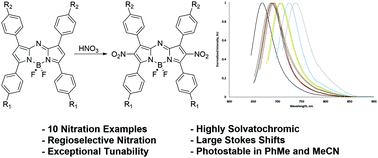Synthesis and photophysical properties of nitrated aza-BODIPYs†
Abstract
A series of ten electron deficient aza-BODIPYs were prepared through a facile nitration strategy where either one, two, or four nitro groups can be regioselectively attached which represents a novel synthetic transformation of the core structure. Installation of the highly withdrawing nitro group on the 2- and 6-positions was found to greatly impact the absorption and emission profiles of the aza-BODIPY core in comparison to their non-nitrated precursors as seen through unusually large negative solvatochromic effects and Stokes shifts, resulting in exceptional photophysical tunability. TD-DFT calculations also revealed that nitration on the 2- and 6-positions greatly stabilized both HOMO and LUMO energy levels by an average of 0.61 eV, resulting in average HOMO and LUMO energies of −4.46 eV and −6.44 eV, respectively. Moreover, preliminary studies suggested that nitrated aza-BODIPYs possess moderate to superior photostabilities when compared to their non-nitrated analogues. Combined, these data demonstrate that nitration of the 2- and 6-positions is a viable strategy in designing effective push–pull aza-BODIPYs with near-IR absorption and emission profiles.



 Please wait while we load your content...
Please wait while we load your content...